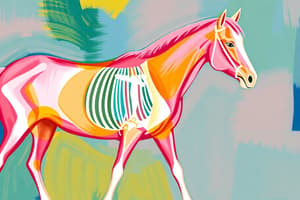Podcast
Questions and Answers
What are some of the predisposing factors that can lead to the development of thrush in horses?
What are some of the predisposing factors that can lead to the development of thrush in horses?
Unhygienic conditions, lack of exercise, poor foot care, fungal infections, abnormal hoof growth, inappropriate or lack of trimming or shoeing, chronic lameness issues, poor circulation to the frog, and horses with deep sulci
What are the characteristic symptoms of thrush in horses?
What are the characteristic symptoms of thrush in horses?
Soft, spongy, disintegrated frog horn with a fetid odor, lameness, inflammation of the coronet, and discharge of pus from fissures in the coronet and heels
How is thrush typically diagnosed in horses?
How is thrush typically diagnosed in horses?
Based on environmental conditions and clinical signs such as black debris/discharge, offensive odor, and frog loss
What are the primary goals of treating thrush in horses?
What are the primary goals of treating thrush in horses?
Why is culturing the foot not typically recommended for diagnosing thrush?
Why is culturing the foot not typically recommended for diagnosing thrush?
What can be done to prevent thrush from developing in horses?
What can be done to prevent thrush from developing in horses?
What is the primary bacterium responsible for causing thrush in horses?
What is the primary bacterium responsible for causing thrush in horses?
What is the typical appearance of the feet of a horse suffering from laminitis?
What is the typical appearance of the feet of a horse suffering from laminitis?
What is the recommended treatment approach for laminitis?
What is the recommended treatment approach for laminitis?
What is the primary location affected by thrush in horses?
What is the primary location affected by thrush in horses?
What is a key preventative measure for laminitis?
What is a key preventative measure for laminitis?
What is the characteristic of the exudate in thrush cases?
What is the characteristic of the exudate in thrush cases?
What is a necessary step in preventing thrush in horses?
What is a necessary step in preventing thrush in horses?
What are the usual causes of lameness above the fetlock origin?
What are the usual causes of lameness above the fetlock origin?
What is a common symptom of contracted flexor tendons?
What is a common symptom of contracted flexor tendons?
What is a key aspect of treating lameness above the fetlock origin?
What is a key aspect of treating lameness above the fetlock origin?
What can be done to educate horse owners to prevent thrush?
What can be done to educate horse owners to prevent thrush?
What is a necessary step in correcting lameness in horses?
What is a necessary step in correcting lameness in horses?
Flashcards are hidden until you start studying



